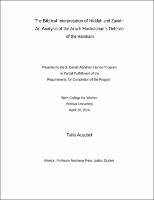Please use this identifier to cite or link to this item:
https://hdl.handle.net/20.500.12202/4231Full metadata record
| DC Field | Value | Language |
|---|---|---|
| dc.contributor.author | Ausubel, Talia | - |
| dc.date.accessioned | 2018-11-12T21:14:54Z | - |
| dc.date.available | 2018-11-12T21:14:54Z | - |
| dc.date.issued | 2014-04 | - |
| dc.identifier.uri | https://hdl.handle.net/20.500.12202/4231 | - |
| dc.identifier.uri | https://ezproxy.yu.edu/login?url=https://repository.yu.edu/handle/20.500.12202/4231 | |
| dc.description | The file is restricted for YU community access only. | - |
| dc.description.abstract | The laws of tumah, impurity and tahara, purity are intricate and complex. They are rooted in the Torah. The Torah lists all of the people and things that can become impure and how this is so.1 There is a list of laws regarding various people who have different types of discharges. Bodily discharge can create a state of impurity for the person. Tumah also transfers from a person to other people or items through various means. Purification processes vary for the different types of bodily discharges and for the tamey person or those who touch him or her. Immersing in a mikvah, a ritual bath, or bringing karbanot, sacrifices, are often parts of this purification process. However, after the Beis Hamikdash was destroyed most of the rules of tumah and tahara are no longer observed as the means of bringing a sacrifice is no longer possible. | en_US |
| dc.description.sponsorship | S. Daniel Abraham Honors Program | en_US |
| dc.language.iso | en_US | en_US |
| dc.publisher | Stern College for Women | en_US |
| dc.rights | Attribution-NonCommercial-NoDerivs 3.0 United States | * |
| dc.rights.uri | http://creativecommons.org/licenses/by-nc-nd/3.0/us/ | * |
| dc.subject | Maimonides, Moses, 1135-1204. | en_US |
| dc.subject | Naḥmanides, approximately 1195-approximately 1270. Hilkhot nidah. | en_US |
| dc.subject | Epstein, Jehiel Michael ben Aaron Isaac, Halevi, approximately 1829-approximately 1908. ʻArukh ha-shulḥan. | en_US |
| dc.subject | Purity, Ritual --Judaism. | en_US |
| dc.subject | Talmud. Niddah --Criticism, interpretation, etc. | en_US |
| dc.title | The Biblical Interpretation of Niddah and Zavah: An Analysis of the Aruch Hashulchan’s Defense of the Rambam | en_US |
| dc.type | Thesis | en_US |
| Appears in Collections: | S. Daniel Abraham Honors Student Theses | |
Files in This Item:
| File | Description | Size | Format | |
|---|---|---|---|---|
| Talia Ausubel.pdf Restricted Access | 687.58 kB | Adobe PDF |  View/Open |
This item is licensed under a Creative Commons License

